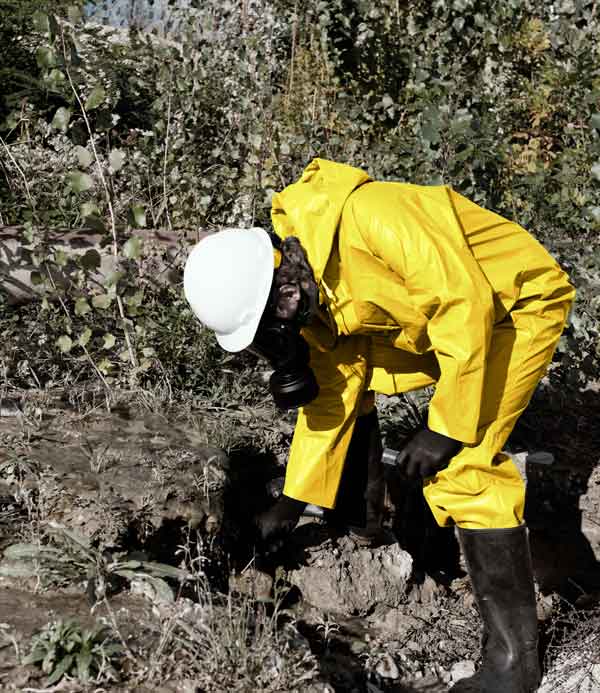How does asbestos affect the environment?
The negative impact of airborne asbestos contamination on human health is now well-documented - but it hasn’t always been. For decades it was a go-to building material in New Zealand’s construction industry, with the fibrous panels useful for their fire-resistance and durability. These positives features meant asbestos was used frequently; as part of walls, ceilings, and internal and external gutters. As such, the material can still be found in commercial, industrial and residential buildings nationwide despite asbestos’ ban as a construction material nationwide over 30 years ago.
With asbestos so widely used in construction for so long, there is a chance your home or business may be at risk. This risk goes beyond just compromising indoor air quality - asbestos affects the environment around us in a number of ways. Here’s a breakdown of how asbestos contamination can impact the external environment.
Compromising soil quality
Asbestos can be found naturally as a silicate substance in rocks and soil worldwide. Because of this, asbestos doesn’t generally contribute to soil degradation, and has shown to have no obvious effect on plant or animal life underground. Indeed, the fibres can be safely contained underground to reduce the risk to humans. However, if excess asbestos dust builds up in one place due to construction activity or illegal dumping, it can mean that the soil, once disturbed, will throw up dangerous clouds into the air.
Because asbestos fibres are so small and light, dust often settles as a layer on top of the ground. If there is significant construction or renovation activity in the surrounding area, this is even more likely. These dust particles can then be carried by the wind further and further away from the original site, increasing overall environmental impact and putting the respiratory health of humans at unnecessary risk. Asbestos buildup in soil around a property can be safely managed by ensuring any asbestos material removed is properly disposed of, and safety gear - such as overalls and respirators - are used at all times.
Deteriorating water quality
Asbestos wasn’t just used as a material for constructing properties nationwide - it was also used to reinforce cement pipes and drainage systems, both inside and outside of buildings. While asbestos proved useful for increasing the durability of concrete, its use also exposed water quality to risk of contamination. Fibre deterioration over time can be hastened by fast-flowing water, meaning asbestos dust can leech into the water supply of your building and be ingested during bathing, cleaning, or drinking.
A further issue with asbestos contaminating water quality is its low biodegrading rate. Because these fibres don’t break down quickly, they can stay in your system for a long time once consumed. It also means fibre particles can spread over vast distances and contaminate lakes, rivers, and other bodies of water, which can eventually contribute to asbestos-fibre buildup in soil.
Impact on pet and wildlife health
Generally, there is very little research on the long-term impact of asbestos contamination to environmental wildlife. However, airborne fibres are proven to contribute toward respiratory problems, so it’s reasonable to assume it will have a similar effect on animals around us.
Indoors, asbestos deterioration could undoubtedly affect your pet’s health. Experts claim it can take up to 50 years after asbestos exposure for mesothelioma and lung cancer to develop in humans, while the eight-year mark is more common in household pets. Symptoms of potential asbestos contamination include abnormal breathlessness, weight loss, and vomiting. If these problems persist, take your pet to a vet for a check-up. Also, try identifying the source of any asbestos-fibre inhalation, especially in your own home, to reduce your own risk of repository problems.
Asbestos can also harm native birds and other surrounding wildlife, especially if the material is illegally dumped. The risk of animals interacting with asbestos and breaking it down further is likely, so any material removed from your property needs to be treated and removed by professionals to reduce potential deterioration.
Need expert asbestos detection help?
With this potential impact in mind, it’s important that everyone bands together to help identify, assess, and manage the environmental damage asbestos can do. Keeping New Zealand clean and safe is everyone’s job - so if you suspect your property may have asbestos deteriorating into the environment, or you identify fibrous material that hasn’t been properly disposed of, reach out to experts in asbestos treatment and removal.
The Chemcare team is focussed on transparency and delivering the safest outcomes for all parties. This is partly thanks to our years of experience and partly because we’re good, everyday Kiwis like you, committed to keeping Aotearoa’s environment clean and safe. To help protect our environment from asbestos contamination, contact Chemcare today.



